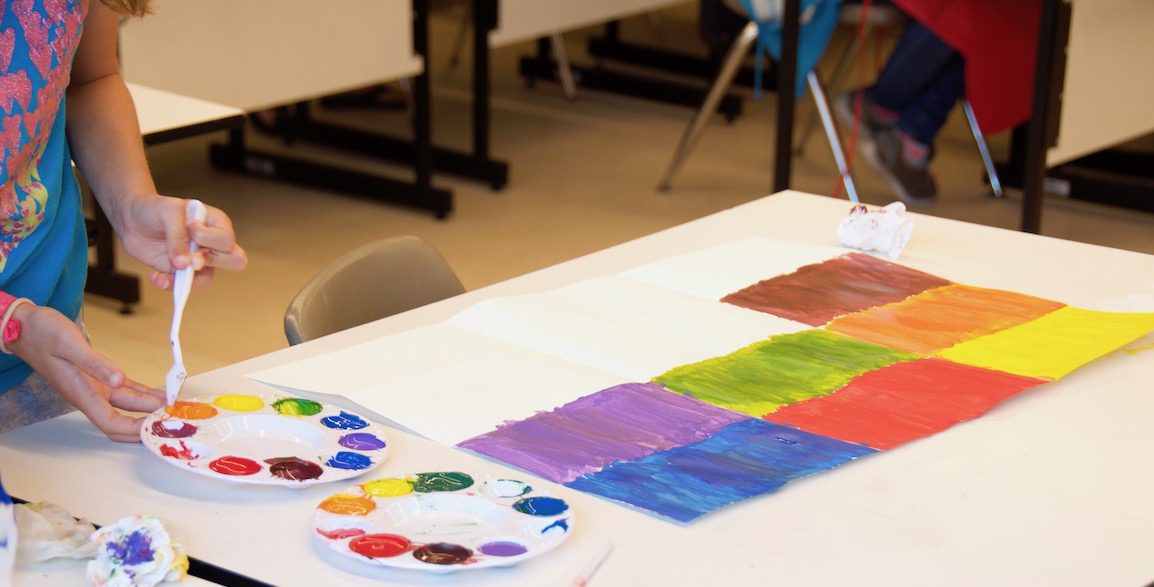Is everyone an artist?
For some, the clear answer is yes; everyone who makes a mark is an artist. For others, it’s less clear. I started grappling with the question after hearing a lot of my colleagues refer to their students as artists. Was I an unsupportive teacher because I didn’t call my students artists? What was the impact of giving students this title?
Let’s dig into this question.

In elementary school, it’s common for teachers to refer to their students as artists. However, it’s rare that you’ll hear a secondary teacher call all or any of their students artists.
Have we thought about how this transition impacts our students?
At first, they are receiving praise and the title of “artist” for putting marks on a page. They happily accept and embrace the title.
But, as students develop, they become more aware of their inability to draw what they see. At the same time, they progress to an environment where the teacher no longer calls them an artist. Does that mean their time as an artist has come to an end? Is their work no longer good?
Most students won’t take the time to reflect, but for the few who do, we leave them with some difficult questions to answer.
- Did they lose the artistic talent they had as a child?
- Was their art teacher lying when he or she called them an artist?
- Should they even bother trying anymore?
Being an artist used to be so fun and easy, now it seems to take hard work and practice.
Students may experience a similar transition as they head off to college. What happens to the highly-praised, rock star artists when they are surrounded by students with the same or better skill levels?
As we think about what we call our students, let’s look at other subjects. Are students also collecting the titles of writer, mathematician, historian, or scientist? Are we undermining the fields of art and art education by saying everyone is an artist? Is there a better alternative? Perhaps what we really should say is that everyone has the potential to creatively express themselves.
Another facet to consider is the effect of the title on a student’s growth mindset.

If you’re not familiar with Growth Mindset, the concept comes from Carol Dweck. Dweck is a professor at Stanford University and the author of Mindset: The New Psychology of Success.
Through researching failure, Dweck found there are two types of mindsets, those that are fixed and those that grow. Students with a fixed mindset believe their level of intelligence is pre-determined and they have little to no control to change it. On the flip side, students with a growth mindset believe intelligence is fluid and can grow and develop over time.
Teaching students to have a growth mindset is common practice in many schools. (We have a Growth Mindset in the Art Room PRO Learning Pack that gives tons of great art room-specific information if you’re interested.)
In short, for students to develop a growth mindset they need to understand how to fail well. They need to believe through hard work they can improve. If students are artists the moment they walk into the art room, how does that impact their growth mindset?
During a research study Dweck found, ability praise pushed students right into the fixed mindset, and they showed all the signs of it, too: When we gave them a choice, they rejected a challenging new task from which they could learn. They didn’t want to do anything that could expose their flaws and call into question their talent. […] In contrast, when students were praised for effort, 90 percent of them wanted the challenging new task from which they could learn.
Growth mindset also puts focus on process praise instead of talent praise. As a culture, we tend to look at artists as though they were simply born with the talent, ignoring the effort they’ve put into their work. When we call students artists, we’re praising talent, not process.
So, what if you’ve been calling your students artists, but now you’re thinking about the impact?
First, take a deep breath and give yourself a high five for taking the time to reflect. Next, if you’re feeling like you want to transition away from calling your students artists, talk to them.
Start by looking at artists and having students reflect on what they think an artist is. Ask students how they think people earn or are given titles. As you look at artists with your students, think about selecting artists that reflect your students.
Here are 3 contemporary artists to explore.
- Nate Lewis
Lewis creates powerful images filled with texture. His work is a combination of photography, drawing, and paper cutting that will blow your mind. - Jamea Richmond-Edwards
Richmond-Edwards creates portraits using ink, graphite, and collage elements. - Lisa Congdon
Congdon creates colorful illustrations, as well as exploring hand lettering and painting.
After looking at artists’ work, ask your students if they feel like they’re artists or not. If they answer yes, discuss how they could improve and set goals. If they answer no, discuss why they feel that way, and explore what might make them feel like an artist.
If you don’t call students artists, what do you call them?

So, if you’re not going to call your students artists, what are some other words you could use?
Fortunately, there’s no right answer to this question. What you do in your classroom needs to fit with your personality and your students’ personalities.
In fact, why not ask them?
Create a powerful experience in which you have a conversation and explore together what words and titles mean to them. Ask your students what they want to be called.
Maybe you decide on art appreciates. (Admittedly, this doesn’t roll off the tongue as easily…) Or, you might decide to call them makers, creators, problem-solvers, or thinkers. Or maybe, you decide calling your students artists is the best thing for them. The beauty is that you and your students will have come up with the solution together.
What do you call your students and what led you that decision?
What’s something you’ll never forget that your art teacher told you?
Magazine articles and podcasts are opinions of professional education contributors and do not necessarily represent the position of the Art of Education University (AOEU) or its academic offerings. Contributors use terms in the way they are most often talked about in the scope of their educational experiences.





